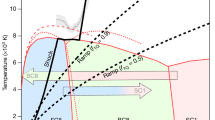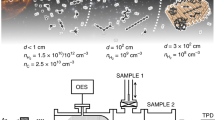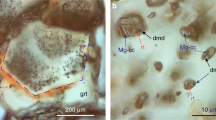Abstract
DIAMONDS just 3–5 nm in diameter have recently been recovered from carbonaceous residues of detonations1. They have also been found in meteorites2, nucleate homogeneously in the gas phase3, and diamond-like films can be grown in low-pressure hydrogen4. Conditions are very different in these four cases, but the nearly equal sizes in both meteorites and detonations, and the necessity of nucleation centres for growth of synthetic diamonds, indicate the existence of a common underlying factor. Ultra-small diamonds, too small to be detected readily, may in fact be far more prevalent than presently realized. We arrive at this conclusion by comparing calculated heats of formation of small tetrahedral (diamond) and hexagonal (graphitic) clusters. In agreement with Nuth's discussions on diamonds in interstellar media5,6, we conclude that surface energies are an important aspect in the stabilization of microcrystalline diamonds. For surface bonds terminated with hydrogen atoms, we find that diamonds smaller than ∼3 nm in diameter are energetically favoured over polycyclic aromatics (the precursors to graphite), withou/equiring the high pressures or extreme kinetic conditions usually associated with diamonds.
This is a preview of subscription content, access via your institution
Access options
Subscribe to this journal
Receive 51 print issues and online access
$199.00 per year
only $3.90 per issue
Buy this article
- Purchase on Springer Link
- Instant access to full article PDF
Prices may be subject to local taxes which are calculated during checkout
Similar content being viewed by others
References
Greiner, N. Roy, Phillips, D. S., Johnson, J. D. & Volk, F. Nature 333, 440–442 (1988).
Lewis, R. S., Ming, T., Wacker, J. F., Anders, E. & Steel, E. Nature 326, 160–162 (1987).
Frenklach, M. et al. J. appl. Phys. 66, 395–399 (1989).
Angus, J. C. & Hyaman, C. C. Science 241, 913–921 (1988).
Nuth, J. A. III Nature 329, 589 (1987).
Nuth, J. A. III Astrophys. Space Sci. 139, 103–109 (1987).
Greiner, N. R. & Hermes, R. Proc. 9th Int. Symp. Detonation (Naval Surface Warfare Center, Silver Spring, in the press).
Ornellas, D. L. Calorimetric Determination of Heat and Products of Detonation for Explosives: October 1961 to April 1982 Lawrence Livermore Natn. Lab. Rep. UCRL-52821 (1982).
Verwoerd, W. S. Surface Sci. 108, 153–168 (1981).
Pate, B. B. Surface Sci. 165, 83–142 (1986).
Derry, T. E., Madiba, C. C. P. & Sellschop, J. P. F. Nucl. Instrum. Meth. 218, 559–562 (1983).
Kroto, H. W., Heath, J. R., O'Brien, S. C., Curl, R. F. & Smallley, R. E. Nature 318, 162–163 (1985).
O'Brien, S. C., Heath, J. R., Kroto, H. W., Curl, R. F. & Smalley, R. E. Chem. Phys. Lett. 132, 99–102 (1986).
Dewar. M. J. S. & Thiel, W. J. Am. chem. Soc. 99, 4899–4907 (1977).
Huang, D., Frenklach, M. & Maroncelli, M. J. phys. Chem. 92, 6379–6381 (1988).
Weast, R. C. (ed.) CRC Handbook of Chemistry and Physics. 70th edn, D50–97 (Chemical Rubber Company, Boca Raton, 1989).
Author information
Authors and Affiliations
Rights and permissions
About this article
Cite this article
Badziag, P., Verwoerd, W., Ellis, W. et al. Nanometre-sized diamonds are more stable than graphite. Nature 343, 244–245 (1990). https://doi.org/10.1038/343244a0
Received:
Accepted:
Issue Date:
DOI: https://doi.org/10.1038/343244a0
This article is cited by
-
A composite monolithic column fabricated with functionalized nanodiamond and its application in separation of small molecules
Journal of Porous Materials (2017)
-
Direct synthesis of nanodiamonds by femtosecond laser irradiation of ethanol
Scientific Reports (2016)
-
Nanodiamond Finding in the Hyblean Shallow Mantle Xenoliths
Scientific Reports (2015)
-
Hardness and modulus of ultrananocrystalline diamond/hydrogenated amorphous carbon composite films prepared by coaxial arc plasma deposition
Applied Physics A (2015)
Comments
By submitting a comment you agree to abide by our Terms and Community Guidelines. If you find something abusive or that does not comply with our terms or guidelines please flag it as inappropriate.



